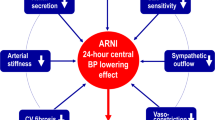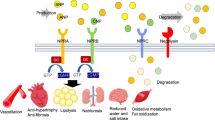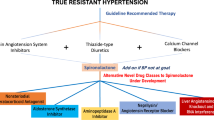Abstract
Angiotensin II receptor blockers represent a class of effective and well tolerated orally active antihypertensive drugs. Activation of AT1 receptors leads to vasoconstriction, stimulation of the release of catecholamines and antidiuretic hormone and promote growth of vascular and cardiac muscle. AT1 receptor blockers antagonise all those effects. Losartan was the first drug of this class marketed, shortly followed by valsartan, irbesartan, telmisartan, candesartan, eprosartan and others on current investigation. All these drugs have the common properties of blockading the AT1 receptor thereby relaxing vascular smooth muscle, increase salt excretion, decrease cellular hypertrophy and induce antihypertensive effect without modifying heart rate or cardiac output. Most of the AT1 receptor blockers in use controlled blood pressure during the 24 h with a once-daily dose, without evidence of producing tolerance to the antihypertensive effect and being with low incidence of side effects even at long term use. Monotherapy in mild-to-moderate hypertension controls blood pressure in 40 to 50% of these patients; when a low dose of thiazide diuretic is added, 60–70% of patients are controlled. The efficacy is similar to angiotensin-converting enzyme (ACE) inhibitors, diuretics, calcium antagonists and beta-blocking agents. AT1 receptor blockers are specially indicated in patients with hypertension who are being treated with ACE inhibitors and developed side effects such as, cough or angioedema. The final position in the antihypertensive therapy in this special population and other clinical situations, such as left ventricular hypertrophy, heart failure, diabetes mellitus and renal disease, has to be determined in large prospective clinical trials, some of which are now being conducted and seem promising.
This is a preview of subscription content, access via your institution
Access options
Subscribe to this journal
Receive 12 digital issues and online access to articles
$119.00 per year
only $9.92 per issue
Buy this article
- Purchase on Springer Link
- Instant access to full article PDF
Prices may be subject to local taxes which are calculated during checkout
Similar content being viewed by others
References
Booz GW, Baker KM . Role of type 1 and type 2 angiotensin receptors in angiotensin II-induced cardiomyocyte hypertrophy Hypertension 1996 28: 635–640
Ford WR, Clanachan AS, Jugdutt BL . Opposite effects of angiotensin AT1 and AT2 receptor antagonist on recovery of mechanical function after ischemia-reperfusion in isolated working rat heart Circulation 1996 94: 3087–3089
Dzau VJ, Mukoyama M, Pratt RE . Molecular biology of angiotensin receptors: target for drug research J Hypertens 1994 12: S1–S5
Streeten DH, Anderson GH Jr, Dalakos TH . Angiotensin II blockade: its clinical significance Am J Med 1976 60: 817–824
Brunner HR, Gavras H, Laragh JH . Specific inhibition of the renin-angiotensin system: a key to understanding blood pressure regulation Prog Cardiovasc Dis 1974 17: 87–98
Furukawa Y, Kishimoto S, Hishikawa K . Tadeka Chemical Industries Ltd Hypotension imidazole-5 acetic acid derivatives. US Patent 4 355 o40, 20 July 1982.
Wexeler RR et al. Rationale for the chemical development of angiotensin II receptor antagonist Am J Hypertens 1992 5: 209S–220S
Chuiu AT et al. Non peptide angiotensin II receptor antagonists, VIII: characterization of functional antagonism displayed by Dup-753, an orally active antihypertensive agent J Pharmacol Exp Ther 1990 252: 711–718
Gansevoor RT et al. Effects of the angiotensin II antagonists losartan in hypertensivepatients with renal disease J Hypertens 1994 12: S37–S42
de Gasparro M, Bottari S, Levens NR . Characteristics of angiotensin II receptor and their role in cell and organ physiology In: Laragh JH, Brenner BM (eds) Hypertension: Pathophysiology; Diagnosis and Management. Second edition Raven Press Thd: New York 1995 pp 1695–1720
Israelli ZH, Hall WD . Cough and angioneurotic edema associated with angiotensin-converting enzyme inhibitors therapy: a review of the literature and pathophysiology Ann Inter Med 1992 117: 234–242
Timmermans PBMW et al. Angiotensin II receptors and functional correlates Am J Hypertens 1992 5: 221S–234S
Garcha RS, Sever PS, Hugles AD . Action of AT1-receptor antagonist on angiotensin II-induced tone in human isolated subcutaneous resistance arteries Br J Pharmacol 1999 127: 1876–1882
Morsing P et al. Mechanistic differences of various AT1-receptor blockers in isolated vessels of different origin Hypertension 1999 33: 1406–1413
Vanderheyden PML et al. Distinction between surmountable and insurmountable selective AT1-receptor antagonists by use of CHO-K1 cells expressing human angiotensin II AT1-receptors Br J Pharmacol 1999 126: 1057–1065
Chiu AT et al. Nonpeptide angiotensin II receptor antagonists. VII. Cellular and biochemical pharmacology of DUP 753, an orally active antihypertensive agent J Pharmacol Exp Ther 1990 252: 711–718
Corriu C, Bernard S, Schott C, Stoclet JC . Effects of losartan on contractile responses of conductance and resistance arteries from rats J Cardiovasc Pharmacol 1995 26: 688–692
Noda M et al. Inhibition of rabbit aortic angiotensin II (AII) receptor by CV-11974, a new nonpeptide AII antagonist Biochem Pharmacol 1993 46: 311–318
Ohlstein E, Brooks D, Feuerstein G, Ruffolo R Jr . Inhibition of sympathetic outflow by the angiotensin II receptor antagonist, eprosartan, but not by losartan, valsartan or irbesartan: relationship to differences in prejunctional angiotensin II receptor blockade Pharmacology 1997 55: 244–251
Hedner T . Management of hypertension: the advent of new angiotensin II receptor antagonist J Hypertens 1999 17 (Suppl 2): S21–S25
Hein L et al. Behavioural and cardiovascular effects of disrupting the angiotensin II type-2 receptor in mice Nature 1995 377: 744–747
Ichiki T et al. Effects on blood pressure and exploratory behaviour of mice lack angiotensin II type-2 receptor Nature 1995 377: 748–750
Tsutsumi Y et al. Angiotensin II type 2 receptor overexpression activates the vascular kinin system and causes vasodilation J Clin Invest 1999 104: 925–935
Nouet S, Nahmias C . Signal transduction from the angiotensin II AT2 receptor Trends Endocrinol Metab 2000 11: 1–6
Hollenberg NK, Sever PS . The past, present and future of hypertension management: a potential role for AT1-receptor antagonists JRAA 2000 1: 5–10
Sasamura H et al. Cloning, characterization and expression of two angiotensin receptor (AT-1) isoforms from the mouse genome Biochem Biophys Res Comun 1992 351: 253–259
de Gasparo M et al. Proposed update of angiotensin receptor nomenclature Hypertension 1995 25: 924–927
Griendling KK, Murphy TJ, Alexander RW . Molecular biology of the renin-angiotensin system Circulation 1993 87: 1816–1824
Siragy HM . The role of the AT2 receptor in hypertension Am J Hypertens 2000 13: 62S–67S
Wong PC et al. Non-peptide angiotensin II receptor antagonists: studies with EXP9270 and DuP 753 Hypertension 1990 15: 823–834
Markahm A, Goa KL . Valsartan. A review of its pharmacology and therapeutic use in essential hypertension Drug 1997 54: 299–311
Ruilope L . Human pharmacokinetic/pharmaco-dynamic profile of irbesartan: a new potent angiotensin II receptor antagonist J Hypertens Suppl 1997 15: S15–S20
Criscione L et al. Valsartan: preclinical and clinical profile of an antihypertensive angiotensin II antagonist Cardiovasc Drug Res 1995 13: 230–250
Weber MA . Comparison of type I angiotensin II receptor blockers and angiotensin-converting enzyme inhibitors in the treatment of hypertension J Hypertens 1997 15: S32–S36
Chan JCN et al. A randomised, double blind, parallel study of the antihypertensive efficacy and safety of losartan potassium compared to felodipine ER in elderlypatients with mild to moderate hypertension J Hum Hypertens 1995 9: 765–771
Mallion JM, Goldberg AI . Global efficacy and tolerability of losartan, and angiotensin II subtype 1-receptor antagonist, in treatment of hypertension Blood Press Suppl 1996 2: 82–86
Soffer BA et al. Effects of losartan on a blackground of hydrochlorothiazide inpatients with hypertension Hypertension 1995 26: 112–117
Gavras I, Gavras H . Effects of eprosartan versus enalapril in hypertensive patients on the renin angiotensin-aldosterone system and safety parameters; results from a 26 week, double-blind, multicenter study Curr Med Res Opin 1999 15: 15–24
Zanchetti A . Candesartan cilexitil and enalapril are of equivalent efficacy inpatients with mild to moderate hypertension J Hum Hypertens 1997 11 (Suppl 2): S57–S59
Pouleur HG . Clinical overview of irbesartan: a new angiotensin II receptor antagonist Am J Hypertens 1997 10 (Suppl): 318S–324S
Ponticelli C on behalf of the Eprosartan Study Group. Comparison of the efficacy of eprosartan and enalapril inpatients with severe hypertension Am J Hypertens 1997 10: 128A (Abstract)
Mallion JM et al. Valsartan, a new angiotensin II antagonist; blood pressure reduction in essential hypertension compared with an angiotensin converting enzyme inhibitor, enalapril Blood Press Monit 1997 2: 179–184
Nakashima M, Uematsu T, Kosuge K, Kanamaru M . Pilot study of the uricosuric effect of DuP-753, a new angiotensin II receptor antagonist, in healthy subjects Eur J Clin Pharmacol 1992 42: 333–335
Oparil S . Newly emerging pharmacologic differences in angiotensin II receptor blockers Am J Hypertens 2000 13: 18S–24S
Brunner Hr, Gavras H, Laragh JH, Keenan R . Angiotensin-II blockade in man by sar1-ala8-angiotensin II for understanding and treatment of high blood pressure Lancet 1973 II: 1045–1048
Israili ZH . Clinical pharmacokinetics of angiotensin II (AT1) receptor blockers in hypertension J Hum Hypertens 2000 14 (Suppl 1): S73–S86
Belt GG et al. Inhibition of angiotensin II pressor response and ex vivo angiotensin II radioligand binding by candesartan cilexetil and losartan in healthy human volunteers J Hum Hypertens 1997 11 (Suppl 2): S45–S47
Gradman AH et al. Assessment of once-daily eprosartan, an angiotensin II antagonist, inpatients with systemic hypertension, Eprosartan Study Group Clin Ther 1999 21: 442–453
Burnier M, Brunner HR . Angiotensin II receptor antagonists in hypertension Kidney Intern 1998 54 (Suppl 68): S107–S111
Ruddy MC, Kostis JB . Angiotensin II receptor antagonist In: Oparil S, Weber M (eds) Hypertension WB Saunders: Philadelphia 1999 Chapter 71 621–636
Dahlöf B, Pennert K, Hansson L . Reversal of left ventricular hypertrophy in hypertensivepatients: a metaanalysis of 109 treatment studies Am J Hypertens 1992 5: 95–110
Cruickshank JM et al. Reversivility of left ventricular hypertrophy by differing types of antyhipertensive therapy J Hum Hypertens 1992 6: 85–90
Mizuno K et al. Effects of losartan, non-peptide angiotensin II receptor antagonist, on cardiac hypertrophy and the tissue angiotensin II content in spontaneously hypertensive rats Life Sci 1992 51: 367–374
Bunkerburg B et al. Receptor-mediated effects of angiotensin II on growth of vascular smooth muscle cells from spontaneously hypertensive rats Hypertension 1992 20: 746–754
Thürmann PA et al. Influence of the angiotensin II antagonist valsartan on left ventricular hypertrophy inpatients with essential hypertension Circulation 1998 98: 2037–2042
Golbert AI, Dunlay MC, Sweet CS . Safety and tolerability of losartan potassium, and angiotensin II receptor antagonist, compared with hydrochrothiazide, atenolol, felodipine AR and angiotensin-converting enzyme inhibitors for the treatment of systemic hypertension Am J Cardiol 1995 75: 793–795
Physician Desk Reference 52 edition Medical Economics Data 1999
Chan P et al. Double-blind comparison of losartan, lisinopril and metolazone in elderly hypertensivepatients with previous angiotensin-converting enzyme inhibitor-induced cough J Clin Pharmacol 1997 37: 253–257
Stettin G et al. One-year persistency and compliance with 5 major classes of antihypertensive therapy (abstract) Clin Pharmacol Ther 1998 63: 197
Author information
Authors and Affiliations
Corresponding author
Rights and permissions
About this article
Cite this article
Hernández-Hernández, R., Sosa-Canache, B., Velasco, M. et al. Angiotensin II receptor antagonists role in arterial hypertension. J Hum Hypertens 16 (Suppl 1), S93–S99 (2002). https://doi.org/10.1038/sj.jhh.1001352
Published:
Issue Date:
DOI: https://doi.org/10.1038/sj.jhh.1001352
Keywords
This article is cited by
-
Angiotensin Receptor Blockers and the Risk of Cancer: Insights from Clinical Trials and Recent Drug Recalls
Current Hypertension Reports (2020)
-
Ambulatory monitoring of systolic hypertension in the elderly: Eprosartan/hydrochlorothiazide compared with losartan/hydrochlorothiazide (INSIST trial)
Advances in Therapy (2010)
-
Hypocalcemia in a patient with severe hypertension and surgically induced relative hypoparathyroidism
Journal of Bone and Mineral Metabolism (2008)
-
Effects of losartan and valsartan on left ventricular hypertrophy and function in essential hypertension
Advances in Therapy (2004)
-
The role of angiotensin II in regulating vascular structural and functional changes in hypertension
Current Hypertension Reports (2003)



